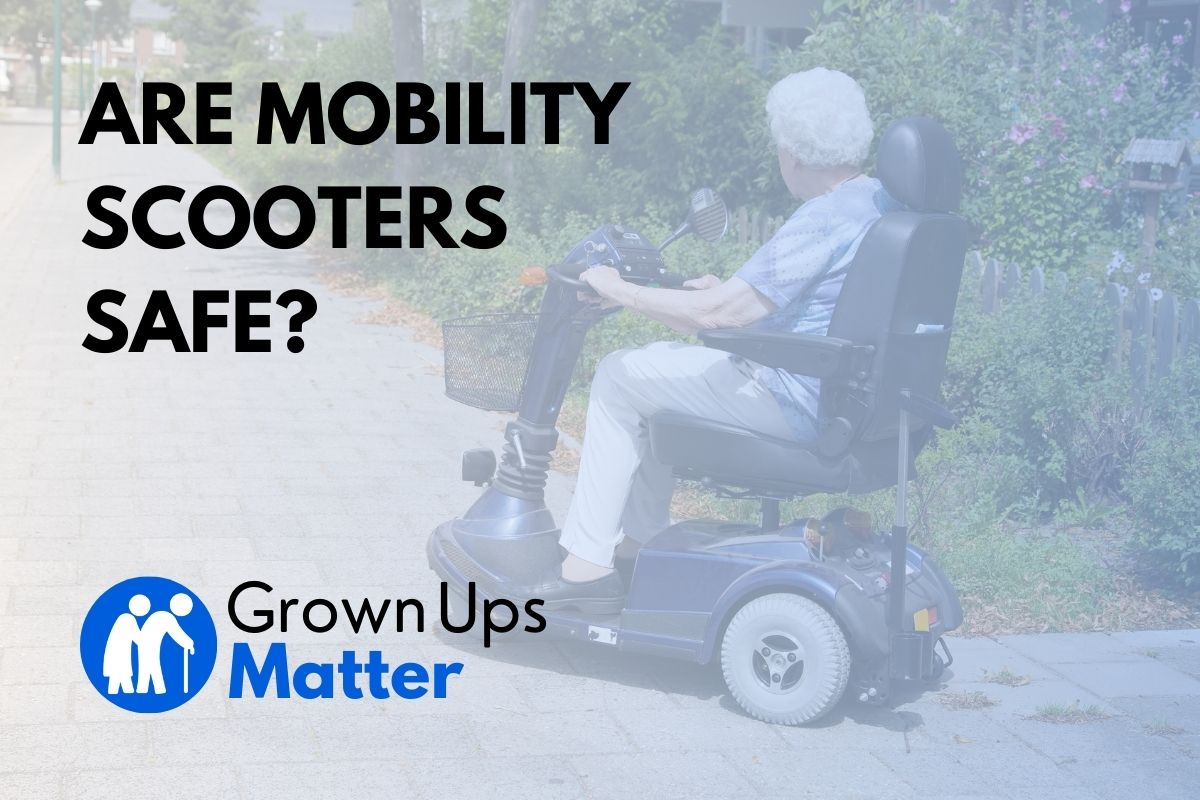Imagine the scene: A sunny afternoon, a gentle breeze in the air, and you’re strolling through your local park on your mobility scooter.
But the question lurks in the back of your mind: How safe is this?
After all, with the increased independence and freedom that mobility scooters offer naturally comes a level of concern regarding safety.
In this article, we’ll explore this crucial question: Are mobility scooters safe?
We’ll discuss the overall safety of mobility scooters, their stability, the common risks, and steps you can take to ensure a secure ride.
You will also find insights about the safety measures different mobility scooter models offer, providing a well-rounded understanding of this popular mode of transport.
By the end, you’ll have a wealth of knowledge to make informed decisions and feel confident about your mobility scooter use.
Key Takeaways
- Mobility Scooters and Safety: Mobility scooters are generally safe for most users, offering independence and improved quality of life. However, their safety can depend on various factors such as the user’s physical condition, proper operation, and maintenance of the scooter.
- Stability of Mobility Scooters: A significant factor impacting the safety of a mobility scooter is its stability. Most scooters are designed with a low center of gravity and wide wheelbase to prevent tipping over. There are differences between 3-wheel and 4-wheel scooters in terms of stability.
- Common Risks of Driving a Mobility Scooter: Although generally safe, there are risks associated with driving a mobility scooter. These can include accidents due to obstacles, incorrect use of controls, tipping over, and driving in unfavorable conditions. Understanding how to drive a mobility scooter properly can minimize these risks.
- Mobility Scooter Accidents: Accidents can happen, although they are relatively rare. When they do occur, the injuries can range from minor bruises to more severe injuries. Careful and attentive driving can reduce the likelihood of accidents.
- Choosing the Safest Mobility Scooter: The safety of a mobility scooter can also depend on the specific model chosen. Certain features, such as seat belts, sturdy construction, and efficient brakes, can contribute to a safer ride. It’s essential to consider these when going through a mobility scooter buying guide.
Each of these points offers a glimpse into the multi-faceted issue of mobility scooter safety. As we delve deeper into these topics, we hope you will find this information beneficial and reassuring.
Are Mobility Scooters Safe?
So, let’s get right to it. Are mobility scooters safe? The simple answer is yes. Mobility scooters, in their essence, are designed with safety as a paramount feature. They provide a means of independent transport for those with mobility limitations, enabling them to navigate their surroundings without assistance.
The speed of a mobility scooter, which typically doesn’t exceed 8 miles per hour, is a critical element of its safety. However, the question of safety is not solely about the design and speed of the mobility scooter. The user’s physical condition, ability to operate the scooter correctly, and the environment in which the scooter is used can all impact the safety levels.
For example, if you’re someone with a severe visual impairment, operating a mobility scooter could pose certain risks. That’s not to say that if you have reduced sight, a mobility scooter is entirely off-limits. Quite the contrary. However, it does mean that you’ll need to take additional precautions. Learn more about using mobility scooters with reduced sight.
A safe environment also plays a role. A smooth, flat surface, free from obstacles, is ideal for a mobility scooter. More challenging terrains, like hills and uneven surfaces, can present some risks. It’s worth noting that there are mobility scooters designed for all-terrain use. Check out our guide on the best all-terrain mobility scooters for more information.
Proper maintenance is another crucial factor. Regular checks and maintenance of the scooter can ensure it remains in optimal working condition, thereby increasing its safety. You can refer to our mobility scooter maintenance guide for more on this.
In conclusion, yes, mobility scooters are safe. However, safety is not just about the device itself, but also about the user and how they interact with their environment.
How Common Are Mobility Scooter Accidents?
While mobility scooters offer increased independence and enhanced quality of life for many people, accidents can and do occur. Research has shown that falls and collisions are the most common types of mobility scooter accidents, though they are not an everyday occurrence.
Statistics on mobility scooter accidents are less comprehensive than data available for cars or motorcycles, but the figures that exist are illuminating. In the UK, for instance, a 2019 study by the Transport Research Laboratory (TRL) found that there were about 260 reported incidents involving mobility scooters in a single year. While this number is relatively small compared to accidents involving other types of vehicles, any accident can be significant for the scooter user involved.
However, it is important to remember that these accidents often happen due to avoidable factors like improper usage or neglect of maintenance. As our mobility scooter safety guide suggests, practicing safe driving habits and maintaining your scooter can drastically reduce the risk of accidents.
How Stable Are Mobility Scooters?
One of the primary concerns many people have regarding mobility scooters is their stability. It is a valid question to ask as stability plays a crucial role in the overall safety of the scooter.
Mobility scooters, whether they are 3-wheel or 4-wheel models, are designed with stability in mind. Their low center of gravity, wide wheelbase, and solid construction all contribute to their overall stability. Moreover, many modern scooters also incorporate anti-tip wheels into their design, which further enhances their stability.
It’s worth noting, however, that not all scooters are created equal, and some may be more stable than others. As such, it’s essential to consider factors such as the type of terrain you’ll be navigating and your specific physical needs when selecting a mobility scooter.
Do Mobility Scooters Tip Over?
Despite their stability-focused design, mobility scooters can tip over under certain circumstances. Typically, tipping occurs if the scooter is driven too fast around a curve or over uneven surfaces, or if the scooter is too heavy for the type and capacity of the model.
However, the risk of a mobility scooter tipping over can be minimized with careful driving and proper maintenance. Keep in mind that each scooter has a maximum weight limit, which includes the user’s weight plus any items being carried. Exceeding this weight limit can increase the risk of tipping.
Understanding the scooter’s limitations, such as its ability to navigate up hills, can also be helpful in preventing accidents.
What Are the Risks of Driving a Mobility Scooter?
As with any vehicle, there are inherent risks associated with driving a mobility scooter. Some of the most common risks include:
- Falls and collisions: These can occur due to various reasons, including improper operation, mechanical failures, or environmental factors such as wet or uneven surfaces.
- Tipping over: As mentioned earlier, this can happen if the scooter is driven too fast around a corner, over uneven surfaces, or if the weight limit of the scooter is exceeded.
- Strains or sprains: These can occur when mounting or dismounting the scooter, or if the scooter stops suddenly and the user is not properly secured.
- Inadequate visibility: This can be an issue when driving at night or in poorly lit areas, making it difficult for others to see the scooter.
Despite these risks, a well-maintained mobility scooter that is used responsibly and within its design parameters can be a safe and practical mobility aid.
What Happens if a Mobility Scooter Hits You?
In the unfortunate event that a mobility scooter hits a pedestrian, the consequences can vary greatly depending on the speed of the scooter, the weight of the scooter plus the driver, and the manner in which the collision occurs.
If the scooter is moving at a slow speed, the pedestrian might escape with minor injuries. But if the scooter is moving at its top speed – which can range from 4 to 8 mph depending on the model – the collision could result in more severe injuries. In any case, it’s essential for the scooter driver to take immediate steps to ensure the safety of all involved and to report the incident to the proper authorities.
In addition, it’s worth mentioning that some insurance policies provide coverage for mobility scooter accidents. For more details on this topic, consider reading our guide on mobility scooter insurance.
What is the Safest Mobility Scooter?
The “safest” mobility scooter can depend on various factors including the individual’s physical needs, the environment where it will be used, and the specific safety features of the scooter.
That being said, there are a few standout models known for their safety features.
For instance, some scooters have automatic braking systems that stop the scooter if the driver releases the control lever, preventing unintended rolling or sudden stops.
Other scooters may include advanced stability features, lighting systems for improved visibility, and even built-in anti-theft devices.
One should consider consulting the mobility scooter buying guide to understand what to look for in a mobility scooter in terms of safety, stability, comfort, and other crucial factors.
Regardless of the model, remember that the safest scooter is one that is used properly, maintained regularly, and tailored to the needs of the individual user.
Safety is as much about the driver as it is about the scooter.
All the claims made in this article are only for informational purposes, based on the writer’s experience and not clinical advice. You should always consult your physician or physical therapist if you have any doubts about how this applies to your specific case.

Mallory is an occupational therapist with a passion for helping the elderly maintain their independence and mobility. After working in the field for several years, she decided to start sharing her knowledge and experience with a wider audience. Through this site, Mallory offers practical tips and exercises to help seniors improve their mobility and manage any limitations they may have. She is dedicated to providing accessible and effective resources to help her readers lead happy and healthy lives.

